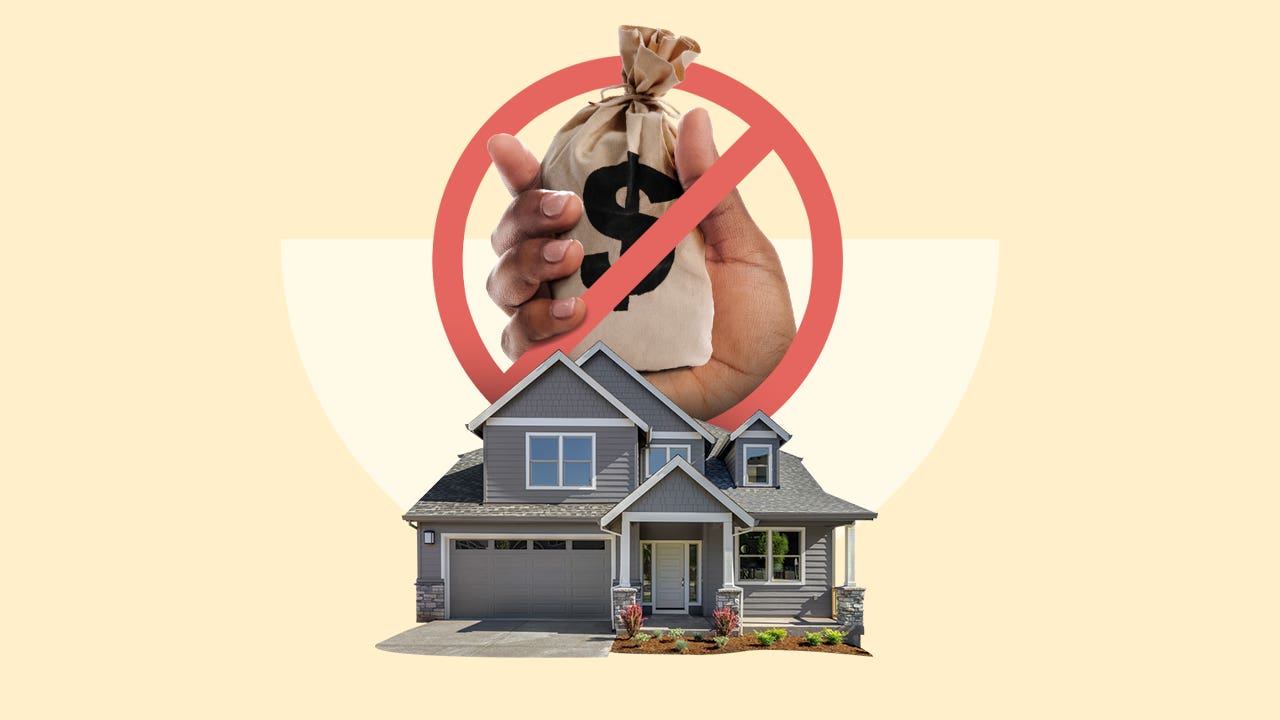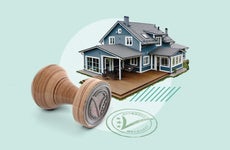Guide to no-down payment mortgages: Am I eligible?

The Bankrate promise
At Bankrate we strive to help you make smarter financial decisions. While we adhere to strict , this post may contain references to products from our partners. Here's an explanation for .
Our writers and editors used an in-house natural language generation platform to assist with portions of this article, allowing them to focus on adding information that is uniquely helpful. The article was reviewed, fact-checked and edited by our editorial staff prior to publication.
Key takeaways
- A no-down payment mortgage allows you to buy a home without putting any money down upfront at closing.
- The two main types of loans that don’t usually require a down payment are VA loans and USDA loans.
- Some alternatives to no-down payment mortgages include low-down payment loans, such as a conventional or FHA loan, down payment assistance and gift funds.
If you qualify for a no-down payment mortgage, you could get a loan for the full purchase price of a home, with no money down upfront. Here’s what you need to know.
What is a no-down payment mortgage?
A no-down payment mortgage is a home loan that allows you to finance 100 percent of the home’s purchase price without having to put any money down at closing. Zero-down mortgages can be particularly beneficial for those buying a home for the first time or with limited savings.
No money down mortgage options
The easiest way to avoid a down payment is to qualify for either a VA loan or USDA loan:
VA loans
If you’re a military service member, veteran or eligible surviving spouse, you might qualify for a VA loan guaranteed by the U.S. Department of Veterans Affairs (VA) with no money down. Unlike a conventional loan, there’s no mortgage insurance requirement for a no-down payment VA loan. However, you do have to pay an upfront funding fee, which can be rolled into the mortgage. This fee ranges from 1.25 percent to 3.3 percent of the loan amount. You can reduce the funding fee by making a down payment.
USDA loans
The U.S. Department of Agriculture (USDA) guarantees USDA home loans for lower- to moderate-income buyers purchasing homes in specially-defined rural areas. These loans don’t require a down payment, but there’s an upfront guarantee fee of 1 percent of the principal loan amount, as well as an annual fee of 0.35 percent, which you can roll into the cost of the mortgage.
Other zero-down mortgage options
- United Wholesale Mortgage, for example, offers lower- to moderate-income borrowers conventional mortgages paired with a no-interest, payment-deferred loan that covers a 3 percent down payment on homes priced up to $500,000. New York-based Sunmark Credit Union offers a no-down payment option that allows the home’s seller to cover the 3 percent minimum down payment requirement.
- If you don’t qualify for a no-down payment program through your lender, your family or a friend might be willing to gift you a 3 percent down payment. If so, you won’t have to put any of your own money down.
- If you’re a doctor or other professional with medical or nursing school debt, you might be eligible for a no-down payment physician mortgage. These provide a workaround for those who expect to earn more money in the future, but might not be able to save for a down payment now due to debt.
Low-down payment mortgage options
If you aren’t eligible for a true no-money down home loan, you might still be able to buy a home with the next best thing: a low-down payment mortgage.
3 percent conventional loans
Fannie Mae and Freddie Mac — the two government-sponsored enterprises underpinning mortgages in the U.S. — back several 3 percent down conventional loan programs:
- Conventional 97
- HomeReady
- Home Possible
- HomeOne
Each of these requires just 3 percent down, but also private mortgage insurance (PMI). The cost of the premiums varies by program and the individual borrower.
FHA loans
Insured by the Federal Housing Administration (FHA), an FHA loan requires only 3.5 percent down with a credit score as low as 580. (If you have a credit score between 500 and 579, you’ll need a higher down payment of 10 percent.) Similar to PMI, you’ll pay FHA mortgage insurance with an FHA loan. However, unlike conventional PMI, you’ll pay FHA premiums for as long as you have the mortgage, in most cases.
1 percent down mortgage programs
Some mortgage lenders offer conventional mortgage programs with only 1 percent down. This includes Rocket Mortgage’s ONE+ program and United Wholesale Mortgage’s Conventional 1% Down program. For these programs, the lender pays 2 percent of the required 3 percent down payment for a HomeReady or Home Possible loan — or up to a maximum contribution that varies by lender and loan size — and you only need to provide the remaining 1 percent.
Good Neighbor Next Door
The Good Neighbor Next Door (GNND) program is for borrowers who work in select public service professions — teachers, firefighters, law enforcement and emergency medical technicians — and plan to buy a home in a qualifying area. Sponsored by the U.S. Department of Housing and Urban Development (HUD), the program provides a discount of up to 50 percent on a home with a down payment of just $100.
Pros and cons of a no-down payment mortgage
The ability to buy a home with no or very little money down can be appealing, but there are drawbacks, too.
Pros of no-down payment mortgages
- You can buy a home now instead of later. When you don’t have to come up with a substantial down payment, it’s easier to buy a home sooner.
- You can keep more cash on hand. Even if you have enough to make a sizable down payment, you might want to keep that money liquid for things like emergency savings, remodeling or investing.
Cons of no-down payment mortgages
- You’ll have no or little equity. Home equity is the portion of your home that isn’t financed by a mortgage. When you start with a low- or zero-down loan, you’ll have little to no equity. If home values fall, you could end up owing more on the home than it’s worth, making it difficult to sell or refinance.
- Your interest rate might be higher. You might pay a higher interest rate for a no- or low-money down loan. That’s because with less money tied up in the home, a mortgage lender might view you as more of a risk. Of course, the higher your interest rate, the more you’ll pay overall.
- You’ll need a bigger mortgage. The less you put down, the more you’ll need to borrow, which means you’ll pay more in interest over the life of the loan.
- You’ll pay fees. Both VA and USDA loans come with fees, which add to the cost of the loan.
Should you get a no-down payment mortgage?
Deciding whether to go for a no-down payment mortgage depends largely on your financial circumstances and goals. Here are a couple of scenarios when a zero-down mortgage might be a good idea:
- If you don’t have a lot of cash
- If you can afford to pay higher monthly payments
- If you plan to stay in the home long-term
- If your rent becomes unaffordable
- If you need or want more space (such as for a growing family)
FAQ on no-down payment mortgages
-
The Department of Veteran Affairs and the U.S. Department of Agriculture don’t set a minimum credit score requirement for VA and USDA loans, respectively. However, most lenders offering these loans do, and they’d want them to be at least in the “fair” range: 620 for VA loans, 640 for USDA loans.
-
If you don’t qualify for a no- or low-down payment mortgage, a down payment assistance program might help. These programs are typically offered to first-time or repeat homebuyers within certain income thresholds based on location, and can often be applied to both the down payment and closing costs.
Related Articles



